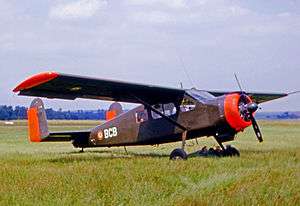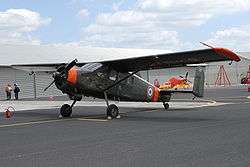Max Holste Broussard
| Broussard | |
|---|---|
 | |
| Operational French Army MH.1521M Broussard at Toussus-le-Noble airfield in 1965 | |
| Role | Six-seat utility monoplane |
| National origin | France |
| Manufacturer | Avions Max Holste |
| First flight | 1952 |
| Introduction | 1954 |
| Retired | 1983 |
| Primary user | French Army |
| Number built | 396 |
| Developed from | Max Holste MH.152 |
The Max Holste MH.1521 Broussard is a 1950s French six-seat utility monoplane designed by Max Holste to meet a French Army requirement.
Design and development
The MH.1521 Broussard was designed to meet a requirement for a lightweight liaison and observation aircraft. It is a braced high-wing monoplane with twin vertical tail surfaces. It has a fixed tailwheel landing gear and is powered by a nose-mounted Pratt & Whitney R-985 radial piston engine.

A smaller 220 hp (164 kW) Salmson 8 As.04 powered prototype aircraft, the MH.152, was first flown on 12 June 1951; it had room for a pilot and four passengers but was too small and underpowered to meet the Army requirement. The company decided to develop a slightly larger version and changed the engine to a Pratt and Whitney Wasp Junior, which at 450 hp provided almost twice as much power. This model was designated the MH.1521 and later named the Broussard (lit. Man of the Bush, in the context of bush pilots rather than Bushmen). Its development was enthusiastically supported at a political level by WWII fighter ace and French war hero Pierre Clostermann, a close friend of Max Holste. Clostermann wrote a faction novel, "Leo 25 Airborne", based on his experiences flying Broussards with Escadrille ELO 3/45 in Algeria.
The prototype Broussard first flew on 17 November 1952 and was followed by the first civil and military production aircraft in June 1954, and 363 were built between 1954 and 1959. Its similarity to the de Havilland Canada DHC-2 Beaver in looks, capability and performance lead it to be nicknamed "the French Beaver".
Operational history
It saw service in the Algerian War as an Army cooperation aircraft, mostly as an artillery spotter and in an air supply/ambulance role where its good short-field performance and resistance to ground fire were required. Its distinctive sound, made by its noisy radial engine and large propeller, was a disadvantage as the Algerian guerrillas could hear its approach long before other aircraft. It remained in service until the 1980s, and can still be seen in Denmark, France, the UK, and the United States being operated by enthusiasts or collectors.
Variants
- MH.152
- First prototype of the Broussard series, powered by a Salmson 8 As.04 inverted V-8 engine.
- MH.1521
- Prototypes, five built plus two pre-production aircraft and 19 pre-production military variants.
- MH.1521A
- Aircraft modified for agricultural use.
- MH.1521C
- Commercial variant, 52 built.
- MH.1521M
- Military variant, 318 built.
- MH.1522
- One modified prototype aircraft flown in 1958 with full span leading-edge slots and double-slotted trailing edge flaps to improve stall performance.
- MH.153
- The prototype MH.152 powered by a Turbomeca Astazou turboprop engine.
Operators
Military operators
- 1
Civil operators
Surviving aircraft

- G-YYYY (s/n 208) flies from Eggesford, UK in 2010.[2]
- F-GIBN (s/n 317) stationed in Walldürn, Germany and in flying condition.[3]
- G-HOUR flies from White Waltham, UK, and owned by luxury watch manufacturer Bremont
- HB-RSL (s/n 6) was stationed in Biel-Kappelen, Switzerland and in flying condition but was destroyed in a hangar fire on July 3, 2016.[4]
- One is in the Musée européen de l’Aviation de Chasse, Montélimar, France.
- N1138V is located at Anchorage, Alaska, USA.
- N246MH 1960 (s/n 246) is located in Friendswood, Texas, USA and in flying condition. [5]
- LN-WNB (s/n 16) stationed at Kjeller, Norway and in flying condition.
- F-GKRO (s/n 154) flies from Rouen Boos and Damyns Hall Aerodrome, UK.
- PG-336 at the Museo Nacional de Aeronautica de Argentina
- VH-HFA (s/n 295), Queensland Air Museum, Caloundra, Australia.
- OY-SLV at Stauning Airport, Denmark. Still in use and usually seen on flying displays at The Danish Air Museum close to Stauning Airport ( ICAO; EKVJ )
- N110TX (s/n P010) is based at Orange, MA Municipal Airport (KORE), USA.
- N4022 (s/n 22) US FAA registered to a German company but operating in California as of Oct 2018.[6]
Specifications (MH.1521M)
Data from The Illustrated Encyclopedia of Aircraft.[7]
General characteristics
- Crew: 1
- Capacity: 5
- Length: 8.65 m (28 ft 4½ in)
- Wingspan: 13.75 m (45 ft 1¼ in)
- Height: 3.65 m (12 ft 0 in)
- Wing area: 25.20 m2 (271.26 ft2)
- Empty weight: 1530 kg (3373 lb)
- Gross weight: 2500 kg (5512 lb)
- Powerplant: 1 × Pratt & Whitney R-985-AN-1 radial piston engine, 336 kW (450 hp)
Performance
- Maximum speed: 270 km/h (168 mph)
- Service ceiling: 5500 m (18045 ft)
See also
Aircraft of comparable role, configuration and era
References
| Wikimedia Commons has media related to Max Holste Broussard. |
- Notes
- ↑ Air International November 1985, pp. 229, 231.
- ↑ "1960 Max Holste MH-1521C-1 Broussard C/N 208". Retrieved November 22, 2013.
- ↑ "OTT 2013: F-GIBN Max Holste MH1521M Broussard". Retrieved November 22, 2013.
- ↑ "Max Holste MH-1521-C1 "Le Broussard" s/n 6". Retrieved November 22, 2013.
- ↑ "960 AVIONS MAX HOLSTE MH 1521 BROUSSARD Serial number 246". Retrieved April 23, 2018.
- ↑ "FAA REGISTRY N-Number Inquiry". FAA. Retrieved 11 October 2018.
- ↑ Orbis 1985, pp 2436
- Bibliography
- Taylor, Michael J. H. (1989). Jane's Encyclopedia of Aviation. London: Studio Editions.
- The Illustrated Encyclopedia of Aircraft (Part Work 1982–1985). Orbis Publishing. p. 2436.
- "The Royal Moroccan Air Force...A Seasoned Air Arm". Air International. Vol. 29 no. 5. November 1985. pp. 226–232, 250–252. ISSN 0306-5634.
- Simpson, R.W. Airlife's General Aviation. England: Airlife Publishing. p. 176. ISBN 1-85310-194-X.
External links
- Max Holste MH.1521 Broussard – surviving aircraft